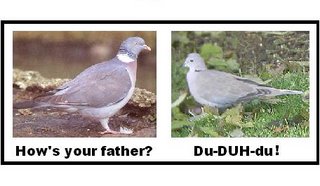 Well, it’s lovely in the Spring, but once you get into mid to late Summer, the only birds still holding territory seem to be Wood Pigeon and Collared Dove, both of which species have taken up residence in my garden. So the dawn chorus consists of the monotony of the Wood Pigeon’s babble, which has the rhythm of a catechism: “How’s your father? All right.” “How’s your mother? Half tight.” “How’s your sister? She might.”. The triplet is usually followed by a stunted “How...?” leaving your hooks on the tenter as you await the completion. No gestalt here, guys. The Collared Dove meanwhile is doing its own moaning repetition of the trisyllabic du-DUH-du du-DUH-du du-DUH-du, interspersed with an eldritch shriek as it flies to an old perch or a new mate.
Well, it’s lovely in the Spring, but once you get into mid to late Summer, the only birds still holding territory seem to be Wood Pigeon and Collared Dove, both of which species have taken up residence in my garden. So the dawn chorus consists of the monotony of the Wood Pigeon’s babble, which has the rhythm of a catechism: “How’s your father? All right.” “How’s your mother? Half tight.” “How’s your sister? She might.”. The triplet is usually followed by a stunted “How...?” leaving your hooks on the tenter as you await the completion. No gestalt here, guys. The Collared Dove meanwhile is doing its own moaning repetition of the trisyllabic du-DUH-du du-DUH-du du-DUH-du, interspersed with an eldritch shriek as it flies to an old perch or a new mate. The scientific name for the Collared Dove is Streptopelia decaocto, and I will explain the derivation, partly to show off my knowledge, and partly to make this Anatolian intruder* a little more palatable. Streptopelia is from Greek streptos, a collar; and peleia. a dove; nothing there to cause a bishop to kick a hole in a stained-glass window. But wait: decaocto is from Latin deca, ten and octo, eight; so the bird’s specific name is “eighteen”. Intrigued? Well, if there’s nothing better on offer, you might as well read on. It comes from a Greek myth about a hardworking maidservant, bemoaning her pay of a miserly 18 sovs a year and praying for release from her misery. The gods heard her and changed her into a dove that echoed her mournful cries. Not many people in Huntingdon know that. Incidentally, there is a parrot in Western Australia, the Port Lincoln Parrot (Barnardius zonarius), that is known locally as the “Twenty-eight bird”, because its call sounds for all the world like a repetition of that number. It is unnerving to be walking along a broad thoroughfare in Perth and have what sounds like an unhinged bank clerk screaming “twenty-eight” in your ear, but it’s not quite as bad as the Collared Dove’s piercing wail.

*The Collared Dove, known in German as the Tuerkentaube – the Turkish Dove – colonised northern Europe starting in the late fifties and is now common everywhere. A typical economic migrant.
No comments:
Post a Comment